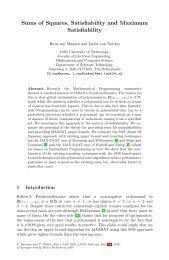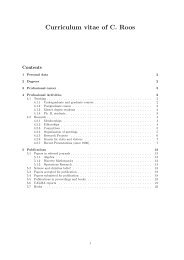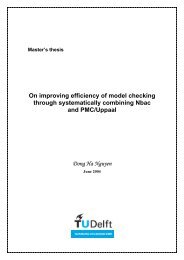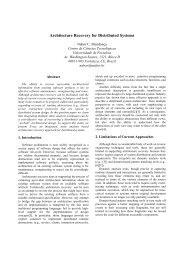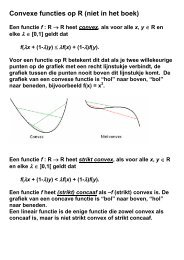Full-Newton step polynomial-time methods for LO based on locally ...
Full-Newton step polynomial-time methods for LO based on locally ...
Full-Newton step polynomial-time methods for LO based on locally ...
Create successful ePaper yourself
Turn your PDF publications into a flip-book with our unique Google optimized e-Paper software.
Relevant part of the analysis of the algorithmAt the start of the first iterati<strong>on</strong> we have x ∈ D and µ = µ 0 such that λ µ (x) ≤ τ. When the barrier parameteris updated to µ + = (1 − θ)µ, Lemma 2 givesλ µ +(x) ≤ λ µ(x) + θ √ ν1 − θ≤ τ + θ√ ν1 − θ . (4)Then after the <str<strong>on</strong>g>Newt<strong>on</strong></str<strong>on</strong>g> <str<strong>on</strong>g>step</str<strong>on</strong>g>, the new iterate is x + = x + ∆x and( ) 2λ µ +(x + λµ +(x)) ≤ κ. (5)1 − κλ µ +(x)The algorithm is well defined if we choose τ and θ such that λ µ +(x + ) ≤ τ. To get the lowest iterati<strong>on</strong> bound,we need at the same <str<strong>on</strong>g>time</str<strong>on</strong>g> to maximize θ. From (5) we deduce that λ µ +(x + ) ≤ τ certainly holds ifλ µ +(x)1 − κλ µ +(x) ≤ √ τ√ κ,which is equivalent to λ µ +(x) ≤the following c<strong>on</strong>diti<strong>on</strong> <strong>on</strong> θ:√ τκ √ τ+ √ κ . According to (4) this will hold if τ+θ√ ν1−θθ ≤ √ τ1 − κτ − √ κτ√ τ +√ νκ( 1 +√ κτ)≤√ τκ √ τ+ √ . This leads toκWe choose τ = 1 9κ . The upper bound <str<strong>on</strong>g>for</str<strong>on</strong>g> θ gets the value 59+36κ √ ν ≤ 12+8κ √ ν , and then λ µ+(x) ≤ 1 4κ .This justifies the choice of the value of τ and θ in the theorem. For the rest of the proof we refer to the relevantreferences.13




